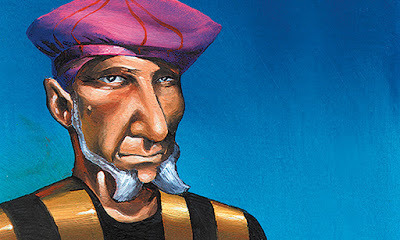On the B/X-ification of Illusionist Spells
 A popular look for illusionists.
A popular look for illusionists.As I mentioned recently, I've been working on the illusionist spell list for B/X Essentials: Advanced Characters.
When converting AD&D material to B/X, the typical case is that the AD&D materials I'm using as inspiration are nowhere near as well written or well thought-out as the native B/X rules. Spells are no different.
My intention with the Advanced Characters and the Druid and Illusionist Spells books is to ensure that the new material is completely in line with B/X, including in terms of clarity and mechanical complexity. Some degree of adaptation is needed, therefore, to bring things in line with B/X. (I'm not making a pure, warts-and-all clone of the AD&D material. See OSRIC for that.)
Some of the illusionist spells are proving to be subtle and tricky, though...
Phantasmal Force
I'm currently pondering phantasmal force -- which exists in both AD&D and B/X -- and have noticed some subtle but important differences between the two versions:
AD&D: "The illusion lasts until struck by an opponent - unless the spell caster causes the illusion to react appropriately - or until the magic-user ceases concentration upon the spell." (PHB75) B/X: "If the caster does not use the spell to attack, the illusion will disappear if it is touched. If the spell is used to "create" a monster, it will have an Armor Class of 9 and will disappear if hit." (B17)
See the difference? In B/X, the illusion disappears when touched or hit in combat; in AD&D, the illusion disappears if hit in combat "unless the spell caster causes the illusion to react appropriately". I would interpret this as meaning that the illusionist would choose for the illusion to react to the hit by recoiling appropriately, appearing wounded, and perhaps behaving more defensively.
Another subtle difference between phantasmal force in B/X and AD&D:
AD&D: "Creatures which disbelieve the phantasmal force gain a saving throw versus the spell, and if they succeed, they see it for what it is". B/X: No mention of disbelief.
I think this second difference helps to explains the first difference:
If an illusory monster in AD&D does not automatically disappear when struck, it would be possible for the illusionist to keep it "alive" indefinitely (the duration of the spell is concentration, after all). What exactly constitutes "causing the illusion to react appropriately" to hits is open to referee interpretation, but it seems to me the intention is that disbelief comes into play here. For example: a fighter, attacking an illusory goblin, deals 8 points of damage. The illusionist describes how the goblin recoils and is slightly grazed. The fighter finds this suspicious -- the blow ought to have killed the goblin! -- and, in the next combat round, attempts to disbelieve that the goblin really exists. A saving throw is then allowed.In B/X, none of this happens. Moldvay apparently made the (I would argue, wise) decision to simplify all of this. An illusion simply disappears when touched.
Higher-Level Illusions
Now we come to the crux of the matter, and the reason why I started looking into these illusions in depth. Phantasmal force is the first spell in a whole "spell chain" in AD&D:
1. Phantasmal force: Visual illusion, concentration duration.
2. Improved phantasmal force: Visual and audio illusion, concentration duration.
3. Spectral force: Visual, audio, and thermal illusion, concentration duration.
5. Advanced illusion: Visual, audio, and thermal illusion, fixed duration (no concentration).
6. Permanent illusion: Visual, audio, and thermal illusion, permanent duration (no concentration).
Only phantasmal force -- the first spell in this chain -- exists in B/X, but I'm adapting the full chain for the BXE illusionist class.
From their descriptions, one can only assume that the whole chain of spells that derive from phantasmal force work in the same way, including this stipulation about illusions being hit in combat, how they may be caused to react, and the clause about disbelief.
Adapting to B/XIn adapting these spells to B/X, I'll need to take this into account.
Perhaps the simplest and most obvious solution would be to say that the B/X phantasmal force rule about an illusion disappearing when touched / struck carries over to the higher level illusions. The problem with this approach, though, is that it greatly weakens the higher level illusions, in particular permanent illusion. A "permanent" illusion that disappears the first time someone touches it makes for a pretty unappealing 6th level spell.
I've been considering a different approach (and this is where we get into the realm of more heavy adaptation of the AD&D spells to B/X): ramping up the realness and stability of higher level illusions. Something like this:Illusions created by phantasmal force and improved phantasmal force disappear when touched or struck in combat.Illusions created by spectral force, advanced illusion, etc. do not disappear when touched or struck in combat. The attacking character may, however, save vs spells. If the save succeeds, the character realises the illusory nature of the monster and can no longer be harmed by it.That seems like a simple approach, and solves the problem of powerful illusions disappearing when touched.
Any thoughts?
Published on November 19, 2018 03:43
No comments have been added yet.
Gavin Norman's Blog
- Gavin Norman's profile
- 32 followers
Gavin Norman isn't a Goodreads Author
(yet),
but they
do have a blog,
so here are some recent posts imported from
their feed.



